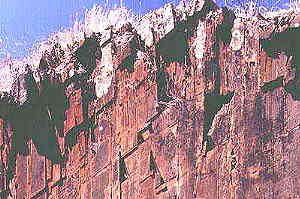

 The geology of the Douro and Côa Valley: general aspects of the rock art areas back to index
The geology of the Douro and Côa Valley: general aspects of the rock art areas back to index | Picture: Rock panel at Ribeira dos Piscos (right up) -> ^ |
 These previously described rocks were submitted to deformation and metamorphism episodes: we can find the traces of this phenomenon in the penetrative foliations, in the faults and in the fractures: other tectonic structures are also examples of such traces. Besides identifying synsedimentary thrust tectonics of Sardic age, the most significant tectonic structures, as also the slaty cleavage in the less metamorphic areas, the schistosity in the areas more metamorphic, and the foids, are the result of the hercyninan tectonic action that was in activity between the Middle Devonian (about 390 Million Years) and the Late Westphalian (About 310 Million Years).
These previously described rocks were submitted to deformation and metamorphism episodes: we can find the traces of this phenomenon in the penetrative foliations, in the faults and in the fractures: other tectonic structures are also examples of such traces. Besides identifying synsedimentary thrust tectonics of Sardic age, the most significant tectonic structures, as also the slaty cleavage in the less metamorphic areas, the schistosity in the areas more metamorphic, and the foids, are the result of the hercyninan tectonic action that was in activity between the Middle Devonian (about 390 Million Years) and the Late Westphalian (About 310 Million Years).| Pictures: ^ <- The rock surface of VRM1 (left up) - | - Vermelhosa area map (center down) |

